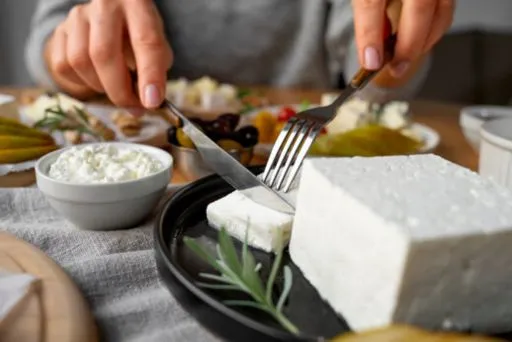Step into the world of culinary trends with good to best! Our latest blog post, “Trendsetting in the Kitchen: The Latest Food Movements to Watch,” delves into the dynamic changes stirring up kitchens everywhere. From the surge of vegan delights to the rich tapestry of Oriental ingredients, these food movements are set to tantalize your taste buds and transform your cooking style. Discover what’s new and exciting in the kitchen with us!
Table of Contents
1. Introduction
Step into the world of culinary trends, where the art of food is constantly evolving and delighting our senses. As a passionate food enthusiast, I’ve always found joy in exploring the latest movements that redefine how we experience and savor food. This year, the culinary landscape is buzzing with exciting innovations, from the rise of plant-based dishes to the infusion of vibrant Oriental flavors that bring a new level of excitement to our kitchens.
Food has always been a central part of our lives, not just for nourishment but as a source of joy, culture, and creativity. The recent trends are a testament to our growing interest in healthier, more sustainable, and globally inspired cuisines. It’s fascinating to see how traditional recipes are being reinvented and how new techniques are being embraced, all in the pursuit of creating extraordinary food experiences.
As we delve into these trends, it’s clear that food is more than just a necessity; it’s a form of expression and connection. Whether it’s the comfort of a homemade meal or the thrill of discovering a new ingredient, the latest culinary trends invite us to explore and celebrate the diversity of flavors. So, let’s embark on this delicious journey together and uncover the trends that are making waves in the kitchen.
- The Rise of New Culinary Trends
The culinary world is always in flux, and the rise of new food trends is a testament to our evolving tastes and values. One of the most notable shifts has been towards plant-based eating. As more people become conscious of their health and the environment, vegan and vegetarian dishes are becoming mainstream. This movement is not just about avoiding animal products; it’s about embracing a variety of fresh, vibrant ingredients that make food both nourishing and exciting.
Another exciting trend is the incorporation of Oriental flavors into everyday cooking. Ingredients like miso, tofu, and a variety of Asian spices are finding their way into our kitchens, adding depth and complexity to our meals. These flavors bring a unique twist to traditional dishes, offering a delicious fusion that bridges East and West. It’s a beautiful example of how food can transcend cultural boundaries and create new culinary experiences.
Sustainability is also at the forefront of new food trends. There’s a growing emphasis on sourcing local and organic ingredients, reducing food waste, and adopting eco-friendly practices in the kitchen. This shift towards sustainable eating is not just a trend but a necessary evolution in how we approach food. It encourages us to be more mindful of our choices and their impact on the planet, all while enjoying fresh and flavorful meals.
These trends are more than just fleeting fads; they reflect a deeper change in how we view food. It’s about celebrating diversity, prioritizing health, and respecting our environment. As we continue to explore these new culinary paths, we’re not only enriching our palates but also contributing to a more sustainable and inclusive food culture. So, let’s embrace these trends and discover the endless possibilities they bring to our kitchen adventures.
2. Embracing Plant-Based Innovations
Exploring the world of food has led me to a thrilling journey into plant-based innovations. This culinary revolution has transformed the way I approach cooking and eating, introducing a vibrant array of flavors and textures that I never knew existed. Plant-based food isn’t just about salads anymore; it’s a celebration of creativity, using ingredients like jackfruit, tempeh, and a variety of legumes to craft dishes that are as satisfying as they are nourishing.
One of the most delightful aspects of embracing plant-based food is the endless possibilities it offers. From creamy cashew-based sauces to hearty mushroom stews, every meal becomes an adventure. The infusion of Oriental flavors, such as miso and sesame, adds a delicious twist that elevates these dishes to a whole new level. The beauty of plant-based cooking lies in its versatility and the way it encourages us to think outside the box.
As I’ve delved deeper into plant-based food, I’ve discovered that it’s not just about health and ethics but also about joy and discovery. There’s something incredibly rewarding about creating a delicious meal from simple, wholesome ingredients. It’s a journey that has made me more connected to my food and appreciative of the natural world. The plant-based movement is more than a trend; it’s a lifestyle that brings both flavor and mindfulness to the table.
- The Popularity of Vegan and Vegetarian Dishes
The rise in popularity of vegan and vegetarian food has been nothing short of remarkable. More people are turning to these diets not only for their health benefits but also for the exciting culinary possibilities they offer. I’ve noticed a significant shift in the food scene, with an increasing number of restaurants and cafes offering creative and delicious plant-based options. This trend has made it easier than ever to enjoy a meat-free lifestyle without feeling deprived.
One reason vegan and vegetarian food has gained such traction is its ability to cater to diverse tastes and preferences. From hearty lentil burgers to creamy coconut curries, there’s a plant-based dish for every palate. The inclusion of exotic ingredients, like tofu and shiitake mushrooms, adds a depth of flavor that makes these dishes stand out. It’s a testament to how innovative and satisfying plant-based cuisine can be.
What I find most exciting is how this trend has encouraged people to experiment in their own kitchens. Social media is flooded with beautiful, mouth-watering images of vegan and vegetarian dishes, inspiring home cooks to try their hand at plant-based cooking. It’s a movement that has brought a new level of excitement and creativity to the world of food. Embracing vegan and vegetarian diets isn’t just about following a trend; it’s about exploring a rich, diverse world of flavors and textures.
- Health Benefits and Environmental Impact
One of the most compelling reasons to embrace plant-based food is its significant health benefits. Since incorporating more plant-based meals into my diet, I’ve experienced increased energy levels, better digestion, and an overall sense of well-being. These diets are rich in essential nutrients, fiber, and antioxidants, which contribute to long-term health. The shift towards plant-based eating has made me more mindful of what I consume and how it affects my body.
Beyond personal health, the environmental impact of plant-based food is profound. The production of plant-based food typically requires fewer resources and generates less pollution compared to animal-based food. This shift towards sustainable eating is crucial for reducing our carbon footprint and preserving natural resources. Knowing that my food choices can positively impact the planet adds an extra layer of satisfaction to every plant-based meal I prepare.
The connection between food and the environment has never been more apparent. By choosing plant-based options, we are supporting a more sustainable and ethical food system. This not only benefits our health but also promotes a healthier planet. It’s empowering to know that simple changes in our diet can lead to significant positive outcomes for both ourselves and the world around us. This awareness has fundamentally changed how I approach food and sustainability.
- Delicious Plant-Based Recipes to Try
One of the joys of exploring plant-based food is discovering a plethora of delicious recipes that make every meal exciting. I’ve found that experimenting with different ingredients and cuisines, particularly those with an Oriental touch, can yield some truly spectacular dishes. For instance, a spicy Thai-inspired tofu stir-fry or a creamy coconut and chickpea curry can bring bold flavors to the dinner table and are surprisingly easy to prepare.
Another favorite of mine is a hearty vegetable ramen, packed with fresh greens, mushrooms, and a rich miso broth. This dish is not only comforting but also incredibly nourishing, showcasing how plant-based food can be both satisfying and healthy. The combination of textures and flavors in these recipes keeps me coming back for more, making plant-based eating a delightful adventure every day.
Desserts are another area where plant-based food shines. From decadent chocolate avocado mousse to light and refreshing mango sticky rice, there’s no shortage of sweet treats that are both indulgent and guilt-free. These recipes often use natural sweeteners and wholesome ingredients, ensuring that desserts can be enjoyed as part of a balanced diet. Exploring plant-based desserts has opened up a new world of flavors and culinary techniques that are both fun and rewarding.
Incorporating plant-based recipes into my daily routine has been a game-changer. It has not only expanded my culinary repertoire but also brought a sense of creativity and joy to cooking. These recipes are a testament to the fact that plant-based food can be incredibly flavorful, versatile, and satisfying. Whether you’re a seasoned vegan or just curious, there’s a whole world of plant-based delights waiting to be discovered.
3. The Allure of Oriental Flavors
One of the most captivating aspects of modern food trends is the rise of Oriental flavors. These rich, complex tastes bring a new dimension to our culinary experiences, blending tradition with innovation. My journey into Oriental cuisine has been a revelation, introducing me to a myriad of spices, sauces, and techniques that have transformed my cooking. The allure of Oriental flavors lies in their ability to create depth and excitement in every dish.
From the umami-rich taste of miso to the aromatic burst of ginger and garlic, Oriental food offers a sensory delight that is both exotic and familiar. These ingredients not only enhance the flavor profile of a dish but also provide numerous health benefits. Incorporating Oriental elements into my meals has allowed me to explore a world of food that is as nutritious as it is delicious. This journey has deepened my appreciation for the diverse and intricate nature of global cuisine.
What I love most about Oriental flavors is their versatility. Whether it’s a simple stir-fry or an elaborate multi-course meal, the use of Oriental ingredients can elevate any dish. The balance of sweet, sour, salty, and spicy in Oriental cuisine creates a harmony that is truly satisfying. This dynamic interplay of flavors has made cooking a more creative and enjoyable process, inspiring me to experiment and innovate in the kitchen.
- Exploring Traditional Oriental Ingredients
Diving into the world of Oriental food has been an adventure in discovering traditional ingredients that are both unique and versatile. Ingredients like soy sauce, sesame oil, and rice vinegar have become staples in my pantry, each adding a distinct flavor and aroma to my dishes. These traditional components are the backbone of many Oriental recipes, providing the authentic taste that defines this cuisine.
One of my favorite discoveries has been tofu, a protein-rich ingredient that absorbs flavors beautifully. It’s incredibly versatile and can be used in a variety of dishes, from stir-fries to soups. The subtle flavor of tofu makes it a perfect canvas for the bold spices and sauces typical of Oriental food. Incorporating tofu into my meals has not only expanded my culinary horizons but also added a healthy and delicious element to my diet.
Another ingredient that has transformed my cooking is miso paste. This fermented soybean paste is packed with umami, adding a deep, savory note to everything from soups to marinades. It’s fascinating how a small amount of miso can completely change the flavor profile of a dish, making it more complex and satisfying. Exploring these traditional ingredients has enriched my understanding and appreciation of Oriental food, inspiring me to experiment and create new recipes.
- Fusion Cuisine: East Meets West
Fusion cuisine, where East meets West, has become a fascinating trend in the food world, blending the best of both culinary traditions. My foray into fusion cooking began with the simple idea of incorporating Oriental flavors into familiar Western dishes. The results have been nothing short of spectacular, with each dish offering a unique and exciting twist on classic recipes. This blend of cuisines brings a fresh perspective to food, making it both innovative and accessible.

One of my favorite fusion dishes is a miso-glazed salmon served with a side of stir-fried vegetables. The rich, umami flavor of the miso complements the delicate taste of the salmon perfectly, while the stir-fried vegetables add a crunchy texture and a burst of color. This dish exemplifies how Oriental flavors can enhance and elevate Western food, creating a harmonious balance that delights the palate.
Another delightful fusion creation is sesame noodle salad, which combines the simplicity of Western pasta with the bold, tangy flavors of an Oriental sesame dressing. The result is a refreshing and satisfying meal that is both light and flavorful. These fusion dishes not only showcase the versatility of food but also highlight how different culinary traditions can come together to create something truly special. Exploring fusion cuisine has been a rewarding journey, inspiring me to continually push the boundaries of my culinary creativity.
- Easy Oriental Recipes for the Home Cook
Incorporating Oriental flavors into home cooking can be both simple and rewarding. One of my go-to recipes is a quick and easy vegetable stir-fry. Using ingredients like soy sauce, garlic, and fresh vegetables, this dish comes together in minutes and is packed with flavor. The key to a great stir-fry is high heat and constant stirring, ensuring that the vegetables remain crisp and the sauce evenly coats each piece. This dish has become a staple in my weekly meal rotation, offering a healthy and delicious option that’s easy to prepare.
Another favorite is a comforting bowl of miso soup. This classic Oriental dish requires just a few ingredients: miso paste, tofu, seaweed, and green onions. It’s a soothing and nutritious option that can be enjoyed as a starter or a light meal. The deep umami flavor of the miso broth is both satisfying and comforting, making it a perfect dish for any time of the year. Preparing miso soup at home has allowed me to appreciate the simplicity and depth of Oriental food.
For a sweet treat, I love making mango sticky rice, a popular Oriental dessert. This dish combines the creamy texture of coconut milk with the sweetness of ripe mangoes and the chewiness of sticky rice. It’s a delightful way to end a meal and is surprisingly easy to make. These recipes demonstrate that incorporating Oriental flavors into home cooking doesn’t have to be complicated. With a few key ingredients and simple techniques, anyone can enjoy the rich and diverse tastes of Oriental food in their own kitchen.
4. Sustainable and Ethical Eating
Embarking on the journey of sustainable and ethical eating has transformed the way I approach food. It’s about more than just what we eat; it’s about making choices that positively impact our health, environment, and society. Embracing this lifestyle has led me to discover a new level of mindfulness and satisfaction in my culinary adventures. Sustainable and ethical eating is not just a trend; it’s a commitment to creating a better world through our daily food choices.
Choosing sustainable and ethical food means prioritizing ingredients that are grown and harvested in ways that respect the environment and the people involved in their production. This approach often involves eating more plant-based foods, which have a lower environmental footprint compared to animal products. It also means being conscious of the origins of our food, ensuring that what we consume is produced ethically and sustainably. This mindful eating practice has deepened my connection to the food I prepare and enjoy.
Incorporating sustainable and ethical eating habits into my daily routine has been incredibly rewarding. Not only do I feel better knowing that my food choices are more responsible, but I’ve also discovered a richer diversity of flavors and ingredients. The journey towards sustainable and ethical eating has made me more creative and thoughtful in the kitchen, constantly seeking out new ways to enjoy delicious, wholesome food that aligns with my values.
- The Importance of Sourcing Local and Organic Foods
One of the key principles of sustainable eating is sourcing local and organic foods. Local food is not only fresher and often more flavorful, but it also supports local farmers and reduces the carbon footprint associated with long-distance transportation. I love visiting farmers’ markets and connecting with the people who grow my food. It gives me a greater appreciation for the hard work that goes into producing fresh, seasonal ingredients.
Organic food is another important aspect of sustainable eating. Organic farming practices avoid the use of synthetic pesticides and fertilizers, promoting healthier soil and ecosystems. When I choose organic food, I know that I am supporting farming methods that are better for the environment and for my health. Organic food often tastes better, too, with a richness and purity of flavor that comes from natural growing methods.
Incorporating local and organic foods into my diet has not only enhanced the quality of my meals but also reinforced my commitment to sustainability. It’s a choice that benefits my health, supports local communities, and helps protect the planet. By prioritizing local and organic food, I feel more connected to the source of my nourishment and more empowered to make a positive impact through my eating habits.
- Reducing Food Waste and Eco-Friendly Practices
Reducing food waste is a crucial component of sustainable and ethical eating. Wasting food means squandering the resources used to produce it, from water and energy to labor and transportation. I’ve become much more conscious of planning my meals and using leftovers creatively to minimize waste. Simple practices like composting food scraps and freezing surplus produce have made a big difference in my kitchen.
Adopting eco-friendly practices goes hand-in-hand with reducing food waste. This includes using reusable bags, containers, and utensils to minimize single-use plastics. I’ve also started buying in bulk to reduce packaging waste and opting for products with minimal or biodegradable packaging. These small changes add up, helping to reduce my environmental footprint and make my kitchen more sustainable.
Incorporating these practices into my daily routine has been a fulfilling challenge. It’s not just about reducing waste, but about respecting the food I have and the effort that went into producing it. Each step towards a more eco-friendly kitchen is a step towards a more sustainable lifestyle, and it’s empowering to know that my choices can make a difference.
- Tips for Creating a Sustainable Kitchen
Creating a sustainable kitchen is all about making thoughtful choices that reduce environmental impact and promote health. One of the first steps I took was to stock my pantry with sustainable food staples like grains, legumes, and spices, which have a long shelf life and can be used in a variety of dishes. Buying in bulk and storing food properly helps to minimize waste and ensure that I always have nutritious options on hand.
Another tip for a sustainable kitchen is to invest in quality, reusable kitchen tools. Items like glass storage containers, cloth produce bags, and stainless steel utensils are durable and reduce the need for disposable products. Switching to energy-efficient appliances and using natural cleaning products also contributes to a more eco-friendly kitchen. These changes not only benefit the environment but also create a healthier space for cooking and eating.
Planning meals and being mindful of portion sizes can significantly reduce food waste. I like to plan my meals for the week, using fresh ingredients first and incorporating leftovers into new dishes. This approach not only saves money but also ensures that I make the most of the food I have. It’s a practice that encourages creativity and resourcefulness in the kitchen, turning sustainable eating into a fun and rewarding experience.
Creating a sustainable kitchen has transformed my approach to food, making it more intentional and fulfilling. Each small change contributes to a larger impact, helping to protect the environment and promote a healthier lifestyle. By embracing these tips and practices, I’ve found a deeper connection to my food and a greater sense of purpose in my culinary journey.
5. Conclusion
Embarking on this culinary journey has been nothing short of exhilarating. The exploration of new food trends, from plant-based innovations to the infusion of Oriental flavors, has transformed the way I approach cooking and eating. Embracing sustainable and ethical eating practices has deepened my connection to the food I prepare and enjoy. This journey has shown me that food is not just about sustenance; it’s about creativity, culture, and conscious living.
The trends we’ve explored together highlight the dynamic nature of food and its ability to adapt and evolve. Whether it’s the rise of vegan and vegetarian dishes, the allure of Oriental ingredients, or the commitment to sustainable practices, each trend offers a unique way to enhance our culinary experiences. This exploration has broadened my horizons, allowing me to appreciate the diversity and richness of global cuisine.
As I continue to experiment and innovate in the kitchen, I am reminded that food is a powerful tool for connection and expression. It’s about more than just flavors and recipes; it’s about sharing and creating memories. This journey has been a reminder of the joy and fulfillment that comes from exploring new culinary paths and embracing the beauty of diverse food traditions.
- Recap of Key Trends
Reflecting on the key food trends we’ve discussed, it’s clear that our culinary landscape is richer and more diverse than ever. The rise of plant-based eating has brought a fresh perspective to traditional meals, emphasizing health and sustainability. The increasing popularity of vegan and vegetarian dishes showcases the versatility and creativity that plant-based food can offer, making it a vibrant part of modern cuisine.
The infusion of Oriental flavors has added depth and complexity to our food, introducing ingredients and techniques that elevate everyday meals. From miso and tofu to ginger and sesame, these flavors bring an exciting twist to both traditional and fusion dishes. Incorporating these elements into my cooking has been a delightful way to explore new culinary territories and appreciate the rich tapestry of global food traditions.
Sustainable and ethical eating practices have also taken center stage, emphasizing the importance of mindful consumption. Sourcing local and organic foods, reducing waste, and adopting eco-friendly practices are essential steps towards a more sustainable lifestyle. These trends not only benefit our health and the environment but also foster a deeper connection to the food we eat and the communities that produce it.
- Encouragement to Experiment and Innovate
One of the most exciting aspects of food is its limitless potential for creativity. I encourage you to experiment and innovate in your kitchen, exploring new ingredients, techniques, and cuisines. Trying out plant-based recipes or incorporating Oriental flavors into your meals can be a fun and rewarding experience. Don’t be afraid to step out of your comfort zone and discover the endless possibilities that food has to offer.
Innovation in the kitchen often starts with curiosity and a willingness to learn. Whether it’s mastering a new cooking technique or experimenting with unfamiliar ingredients, each step is an opportunity to grow and expand your culinary skills. The joy of cooking comes from these moments of discovery and the satisfaction of creating something unique and delicious.
Remember, food is a journey, not a destination. Embrace the process of experimentation and enjoy the surprises along the way. Every dish you create is a reflection of your personal tastes and creativity. By continually exploring and innovating, you’ll not only enhance your culinary repertoire but also deepen your appreciation for the art and science of food.
- Final Thoughts and Invitation to Share Your Experiences
As we conclude this exploration of food trends and sustainable practices, I invite you to reflect on your own culinary journey. What new ingredients or techniques have you discovered? How have these trends influenced your approach to cooking and eating? Sharing our experiences and insights can inspire others and build a community of food enthusiasts who are passionate about exploring and celebrating diverse cuisines.
Your experiences and stories are valuable, and I encourage you to share them. Whether it’s a favorite plant-based recipe, a successful fusion dish, or a tip for reducing food waste, your contributions can inspire and educate others. Let’s continue this conversation and support each other in our quest for delicious, sustainable, and innovative food.
In closing, remember that food is more than just nourishment; it’s a celebration of culture, creativity, and connection. By embracing these trends and practices, we can create a more flavorful, mindful, and sustainable culinary world. I look forward to hearing about your culinary adventures and the new discoveries you make along the way. Happy cooking!
I’d love to hear about your culinary adventures and experiences! Please share your thoughts and feedback in the comments below. Your insights are invaluable and help us all learn and grow together.


















































